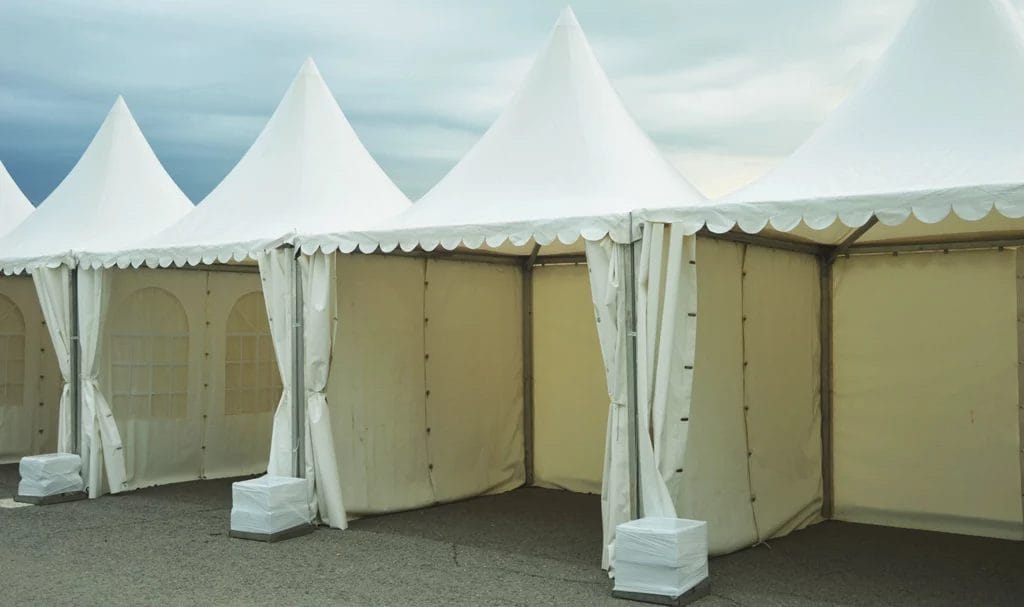It’s a perfect afternoon at an art festival — the crowd is flowing, artists are happily chatting with guests, and a food truck is almost sold out of its popular cookies.
Until suddenly, the afternoon is not so perfect:
- Someone walking past a display trips over an electrical cord, breaking their hip.
- The food truck owner accidentally knocks the parking brake out of gear when running out to help, sending it rolling into the wall of the building.
- A sudden change in weather brings a strong gust of wind that sends a tent flying into cars in the parking lot.
This domino effect of accidents is unlikely, but any one of them could occur at any moment. That’s why it’s important to have vendor insurance, and why so many events require vendors to be insured, provide proof, and add them as an additional insured.
How to Meet Common Insurance Requirements for Vendors
The most common vendor insurance requirements include:
- Having an active General Liability Insurance policy
- Providing proof of insurance with a Certificate of Insurance (COI) – also called an ACORD form
- Adding the venue, organizer, or other third parties to your policy as additional insureds
Typically, you must have insurance before you can sell or exhibit at an event. Luckily, Insurance Canopy helps you easily meet these requirements. Complete our fast online application and get affordable proof of insurance within minutes.
Proof of Vendor Insurance Instantly
Get an instant Certificate of Insurance when you buy a policy online today.
Buy a Vendor General Liability Policy
What to look for when buying a vendor general liability policy:
- Ensure the coverage limits meet or exceed your minimum requirements
- Look for other coverages that are included or offered with your policy
- Be aware of deductibles you would need to pay before insurance kicks in
First, buy a general liability policy from a reputable insurance company to meet vendor insurance requirements. This policy can be for either short or long-term coverage. It’s designed to protect you from claims of third-party bodily injury and property damage at events where you sell or exhibit.
You’ll likely be asked to have a policy with a minimum of $2 million aggregate (per policy term) and $1 million per occurrence (per claim) in coverage. While it might seem like a lot, if someone filed a lawsuit over a simple slip and fall accident, you could be looking at paying medical bills, lost wages, legal fees, and more.

Supply Proof of Vendor Insurance
How to provide vendor proof of insurance:
- Access your policy documents from your online account
- Download a copy of your Certificate of Insurance (aka COI or ACORD)
- Print or email the copy to the requesting party
Vendor insurance requirements usually include being asked to show proof of insurance. This is an official document provided by your insurance company that includes:
- Insurance coverage and limits
- Policy length (start and end dates)
- Policyholder information
- Exclusions
- Additional insured information
You can use this document to prove you meet the insurance requirements. Plus, it makes your business appear more credible, so you’re likely to be hired or accepted as a vendor.
Add Required Additional Insureds to Your Policy
How to add a vendor additional insured:
- Ensure you have the additional insured’s name, address, and contact information
- Enter this info to add additional insureds during the online application, or
- Add them to your policy post-purchase from your online account
It’s common for the same person or entity requiring you to have insurance (like an event organizer, landlord, venue, or business) to require they be added as an “additional insured” (or AI) on your vendor policy. This extends your coverage to them in the event of an accident or claim.

5 Ways to Mitigate Your Risks as a Vendor
At some point in your vendor career, you’re likely to witness or experience third-party injuries or damages, or unexpected weather. All of these pose serious risks to you while at an event, but there are ways you can reduce or eliminate accidents and expensive claims.
Protect Yourself With Insurance
Floors can be scuffed, walls can be marked up, doors or windows can break, lights can be shattered, or grass can be killed by mistake — and you can be on the hook for paying for repairs or replacements.
Having the right coverage can help protect you and your finances by lowering or eliminating the cost of a claim. Vendor liability insurance is designed to be a safety net for those “uh-oh!” moments.
Adhere to Rules and Regulations
Following requirements for required permits, safety guidelines, and health standards can help prevent accidents and lower your risks. Make sure you take the time to understand and prepare ahead of the event.
Use Reliable Equipment
Check your equipment before the event to ensure it’s in good working condition and meets safety standards. This helps you operate during the event and prevents malfunctions or hazards for guests.
Prepare for Weather
The last thing you want to see soaring through the air is part of your display. Unfortunately, this is an all too common risk vendors face at events (well, maybe just the outdoor ones).
Be ready for whatever Mother Nature throws your way. Have the right gear to shield you and your equipment from the hot sun or sudden rain, and use weights or straps to keep gear in place in case of wind.

Frequently Asked Questions (FAQs)
Do Vendors Need to Carry Insurance?
Yes, vendors need to carry insurance to meet event or venue insurance requirements and protect themselves from costly claims.
If you are attending an event to sell products, promote your business, provide food or drinks, or are hired for your services, vendor liability coverage is a must.
What Types of Vendors Need Insurance?
All vendors need insurance, from businesses that operate a booth, kiosk, stall, or space or provide professional services like DJing, performing music, or photography.
How Much Does Vendor Insurance Cost?
The cost of vendor insurance starts at $49/event for standard general liability coverage. Prices can vary based on your policy length, policy type, and additional coverages you may add.
Can I Purchase Vendor Insurance for One Day?
Yes, you can purchase 1-day vendor insurance from Insurance Canopy.
Select the 1–3 day policy option in our online application and complete the checkout process to buy your policy and receive instant proof of insurance.
As a bonus, you’ll also automatically get two extra days of coverage to help you stay safe before, during, and after your event.




